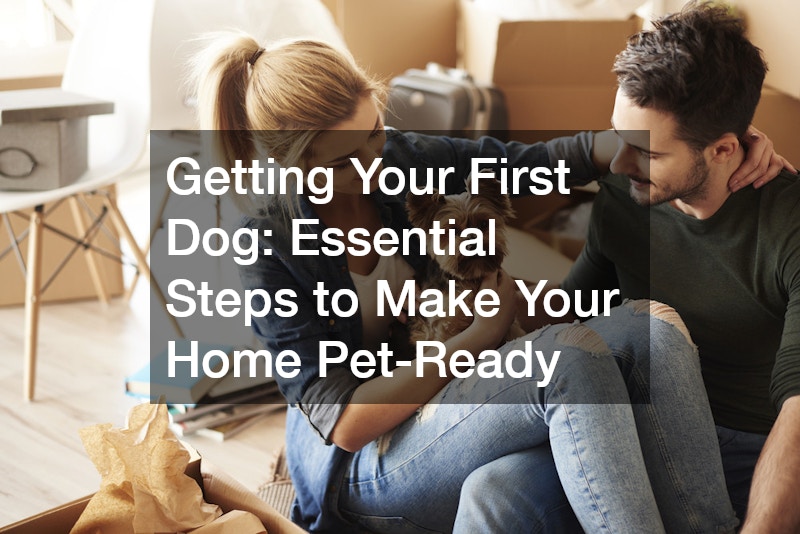Bringing a new dog into your home is an exciting and rewarding experience. Whether you’re getting your first dog or adding another furry friend to your family, there are many important considerations to keep in mind to ensure your pet’s safety and comfort. From scheduling regular grooming appointments to preparing your home and yard for your new companion, this guide will provide you with the information you need to create a welcoming environment for your four-legged friend.
Preparing for Your Dog’s Staycation
When you are away, you may need to consider dog boarding services to ensure your pet is well-cared for in your absence. This can provide peace of mind knowing your dog is safe and happy while you’re away. Additionally, if you are getting your first dog, it’s important to research and select a reputable facility that meets your pet’s needs.
Make sure to visit the dog boarding facility before your trip to check the accommodations and meet the staff. This will help you feel more comfortable leaving your furry friend in their care. Remember to provide all necessary information about your dog’s feeding schedule, medication, and any special requirements.
Upon your return, be sure to ask for feedback about your dog’s stay and if there were any issues that need to be addressed. This will help you make more informed decisions on future boarding options and ensure your dog has a positive experience.

Scheduling Regular Grooming and Care
Regular grooming is essential to keep your dog looking and feeling their best. Consider using a professional dog grooming service to ensure your pet receives the proper care and attention they deserve. This can include bathing, brushing, nail trimming, and ear cleaning to maintain your dog’s overall health and hygiene.
When getting your first dog, it’s important to establish a grooming routine early on to help them become comfortable with the grooming process. Choose a groomer that is experienced with your dog’s breed and temperament to provide the best possible care. Regular grooming sessions can also help you bond with your new pet and create a stress-free environment for them.
Aside from grooming, make sure to schedule routine veterinary check-ups to monitor your dog’s health and address any potential issues early on. Your local veterinarian can provide valuable advice on nutrition, exercise, and preventative care to keep your dog happy and healthy for years to come.
Preparing Your Home for Your New Pet
Before bringing your new dog home, take the time to pet-proof your living space to ensure their safety and comfort. This may include rescreening windows and doors to prevent escapes or accidents. Secure any hazardous materials or objects that your dog could potentially access and remove any plants that may be toxic to pets.
Creating a designated area for your dog to relax and rest can help them feel at ease in their new environment. Provide comfortable bedding, toys, and access to water and food to create a welcoming space for your pet. Consider using baby gates to restrict access to certain areas of your home until your dog becomes familiar with their surroundings.
As part of the preparation process, make sure to stock up on essential supplies such as food, water bowls, leash, collar, and identification tags. Having these items on hand will make the transition smoother for both you and your new furry friend, allowing them to settle in and feel at home in no time.
Choosing the Right Type of Fencing for Your Yard
Installing a secure fence around your yard is essential for keeping your dog safe and contained while they play and explore outdoors. Consider using chain link fencing for its durability and affordability, which provides a strong barrier to prevent your dog from wandering off or encountering potential dangers. Make sure the fence is tall enough to prevent jumping and digging underneath.
When getting your first dog, it’s important to assess your yard’s fencing needs based on your pet’s size, breed, and behavior. Some dogs may require a higher fence to prevent them from escaping, while others may need additional reinforcement to deter them from chewing or scratching the fencing material. Regularly inspect the fence for any damage or weak spots that could compromise your dog’s safety.
Aside from physical barriers, consider installing a secure gate with a self-locking mechanism to further prevent your dog from escaping. This will give you peace of mind knowing your pet is contained within your property and protected from potential hazards. Working with a reputable fencing contractor can help you choose the right fencing options that suit your dog’s needs and maximize their outdoor enjoyment.

Ensuring Your Home is Pest-Free for Your Dog
Keeping your home free of pests is essential for your dog’s health and well-being. Consider scheduling regular pest control treatments to eliminate insects, rodents, and other pests that can harm your pet or transmit diseases. Insecticides can be toxic to dogs, so choose pet-safe pest control methods that are effective yet safe for your furry friend.
When getting your first dog, it’s important to be proactive in preventing pest infestations in your home and yard. Seal any cracks or crevices where pests can enter, and store food and garbage in secure containers to avoid attracting unwanted visitors. Regularly clean and vacuum your home to reduce the risk of pests and maintain a clean living environment for you and your pet.
If you suspect a pest infestation in your home, contact a professional pest control service to address the issue promptly and effectively. They can provide you with customized treatment options and preventive measures to keep your home pest-free and ensure your dog’s safety and comfort. By taking proactive steps to prevent pests, you can create a healthy and welcoming environment for your new four-legged family member.
Landscaping Considerations for Dog Safety
Creating a dog-friendly landscape is essential for providing your pet with a safe and enjoyable outdoor environment. Consider hiring a land clearing service to remove obstacles, hazardous plants, and debris that could pose a danger to your dog. This will create a clear and open space for your pet to play, exercise, and explore without the risk of injury.
When getting your first dog, it’s important to assess your yard’s landscaping and make necessary adjustments to accommodate your pet’s needs. Make sure to plant pet-friendly vegetation that is non-toxic and safe for dogs to ingest. Create shady areas with trees or awnings to provide relief from the sun and keep your dog cool during hot weather.
Designate specific areas for your dog to relieve themselves and consider installing a dog-friendly turf or artificial grass for easy cleanup and maintenance. Avoid using chemicals or fertilizers that may be harmful to pets and opt for natural alternatives that are safe for your dog and the environment. By creating a dog-friendly landscape, you can enhance your pet’s outdoor experience and encourage healthy habits for them to enjoy their time outside.

Establishing a Relationship with Your Local Vet
Building a strong relationship with your local veterinarian is crucial for ensuring your dog’s health and well-being throughout their life. Schedule regular check-ups and vaccinations to monitor your pet’s health and address any concerns or issues early on. Your local veterinarian can provide valuable advice on nutrition, exercise, and preventative care to keep your dog happy and healthy.
When getting your first dog, it’s important to find a veterinarian that is knowledgeable, compassionate, and experienced in treating dogs. Consider scheduling a meet and greet appointment to familiarize your pet with the clinic environment and staff. This will help your dog feel more comfortable and relaxed during future visits for medical care or routine check-ups.
Establish open communication with your veterinarian and discuss any changes in your dog’s behavior, appetite, or health that may require attention. They can provide guidance on proper diet, exercise, dental care, and parasite prevention to keep your dog in optimal health. By working closely with your local vet, you can provide the best possible care for your furry companion and ensure they lead a long and happy life by your side.

Creating a Dog-Friendly Lawn
Designing a dog-friendly lawn is essential for providing your pet with a safe and comfortable outdoor space to play and relax. Consider installing artificial grass for its durability, low maintenance, and pet-friendly features that make it ideal for dogs. This synthetic turf provides a soft and cushioned surface for your pet to run, jump, and roll around without the risk of injuries.
When getting your first dog, it’s important to create a designated area in your yard for them to relieve themselves and play. Artificial grass is easy to clean and resistant to odors, making it a convenient option for pet owners. Make sure to regularly remove solid waste and hose down the grass to maintain a clean and sanitary environment for your dog.
Aside from artificial grass installation, consider adding dog-friendly features to your lawn such as shade structures, water bowls, and pet-safe plants. Incorporating these elements will enhance your dog’s outdoor experience and encourage them to spend more time outside. By creating a dog-friendly lawn, you can create a safe and enjoyable environment for your pet to enjoy the great outdoors.
Customizing Your Entryway for Dog Safety and Comfort
Customizing your entryway with your dog’s needs in mind is essential for ensuring their safety and comfort as they enter and exit your home. Consider installing a custom door or gate with pet-safe features such as a pet door or self-locking mechanism. This will prevent your dog from escaping or encountering potential hazards near the entrance.
When getting your first dog, it’s important to create a designated area in your entryway for your pet’s belongings such as leash, collar, and outdoor toys. This will help them associate the entryway with positive experiences and create a sense of routine when going in and out of your home. Place a mat or towel near the door to wipe off your dog’s paws and prevent dirt and debris from tracking inside.
Make sure to store cleaning supplies, pet waste bags, and other essentials near the entryway for easy access when taking your dog out for walks or potty breaks. Establish a pet-friendly routine for entering and leaving the house to create a smooth and stress-free experience for both you and your furry friend. By customizing your entryway for dog safety and comfort, you can create a welcoming and secure environment for your pet to enjoy their time indoors and outdoors.
Ensuring Proper Tree Care and Maintenance
Maintaining your trees and shrubs is essential for ensuring your dog’s safety and enjoyment in your yard. Consider hiring a tree trimming service to prune overgrown branches, remove dead or diseased trees, and shape your landscape to prevent hazards and accidents. This will create a safe and healthy environment for your pet to explore and play.
When getting your first dog, it’s important to inspect your trees for signs of damage or decay that could pose a danger to your pet. Look for loose branches, hanging limbs, or leaning trees that may require professional attention. Regular tree maintenance can prevent injuries, property damage, and potential emergencies that could harm your dog or family.
Make sure to create a designated play area away from trees and shrubs that may contain toxic plants or sharp thorns that could injure your dog. Consider planting pet-safe trees and bushes that provide shade, visual interest, and a safe environment for your furry friend to enjoy. By ensuring proper tree care and maintenance, you can create a beautiful and functional landscape that enhances your dog’s outdoor experience and promotes their well-being.
Creating a safe and welcoming environment for your new dog involves careful planning, preparation, and ongoing maintenance to ensure their health and happiness. From scheduling regular grooming appointments to landscaping your yard for pet safety, each step plays a crucial role in creating a harmonious home for your furry companion. By following the tips and recommendations outlined in this guide, you can provide the best possible care for your dog and create a loving and enjoyable environment for them to thrive.







